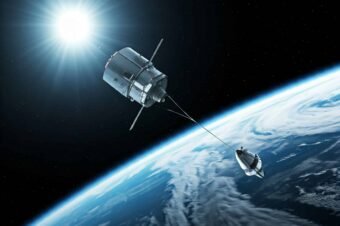Planetary Defense – DE-STAR
http://www.deepspace.ucsb.edu/projects/directed-energy-planetary-defense
Asteroids and comets that cross Earth’s orbit pose a credible risk of impact, with potentially severe disturbances to Earth and society. Numerous risk mitigation strategies have been described, most involving dedicated missions to a threatening object. We propose an orbital planetary defense system capable of heating the surface of potentially hazardous objects to the vaporization point as a feasible approach to impact risk mitigation. We call the system DE-STAR for Directed Energy System for Targeting of Asteroids and exploRation. DE-STAR is a modular phased array of kilowatt class lasers powered by photovoltaic’s. Modular design allows for incremental development, test, and initial deployment, lowering cost, minimizing risk, and allowing for technological co-development, leading eventually to an orbiting structure that would be developed in stages with both technological and target milestones. The main objective of DE-STAR is to use the focused directed energy to raise the surface spot temperature to ~3,000K, allowing direct vaporization of all known substances. In the process of heating the surface ejecting evaporated material a large reaction force would alter the asteroid’s orbit. The baseline system is a DE-STAR 3 or 4 (1-10km array) depending on the degree of protection desired. A DE-STAR 4 allows for asteroid engagement starting beyond 1AU with a spot temperature sufficient to completely evaporate up to 500-m diameter asteroids in one year and can deflect multi km diameter asteroids if needed. Small asteroids and comets can be diverted/evaporated with a DE-STAR 2 (100m) while space debris is vaporized with a DE-STAR 1 (10m). The system is inherently modular and is assembled from a number of identical sub assemblies, allowing for mass production, each of which is small enough to fit into a launch shroud. The system is inherently multi-tasking and can simultaneous engage multiple target or missions. Additional mission tasks include powering or recharging of very distant probes, standoff power to remote facilities, standoff photon drive propulsion of small spacecraft that can achieve mildly relativistic speeds, laser powered conventional (thermal) propulsion (no oxidizer needed), laser powered ion dive, standoff composition analysis of remote objects including asteroids, active illumination detection of asteroids (LIDAR), space debris removal, SPS mode for sending excess powered to the ground or airborne systems via micro or millimeter waves as well as laser, satellite orbital boosting (LEO to GEO for example), extremely long range high speed IR communications to spacecraft and exoplanets and standoff terraforming possibilities among many others. Smaller versions of the same system design can be used for “stand-on” applications for orbital diversion by taking the laser system to the target asteroid in a dedicated mission as well as for close in composition analysis etc.








Leave a Reply